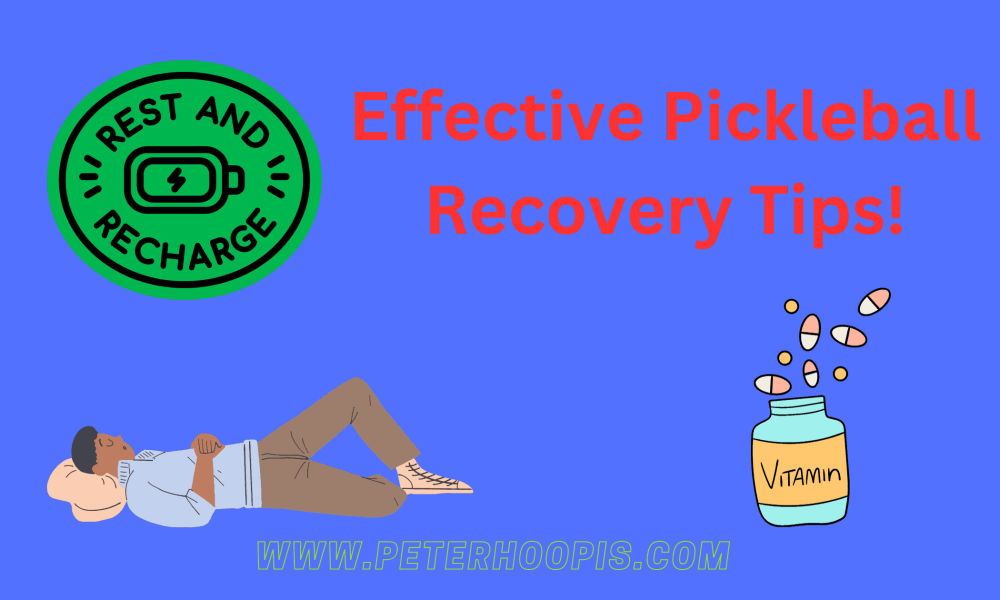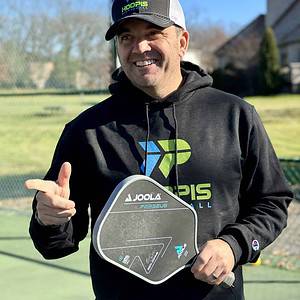Playing pickleball is super fun, but it can also be physically demanding on your body. It’s a game that can push us to our limits, to play harder, faster, and more frequently.
But with all this constant play, we also need to prioritize effective recovery for pickleball – the unsung hero of any sports regimen!
I got hooked…fast; and I was trying to play as much as I could. But sometimes my mid (to late ?) 40 year old body just would cooperate. So I had to make some adjustments so I could stay out on the court longer.
In this blog post, we explore pickleball recovery tips– the art and science behind it. I’ll provide valuable tips to help you recover faster between games and introduce innovative devices and aids to get you back on the court faster with less muscle soreness.
So, whether you’re a seasoned player or just starting to catch that pickleball bug, this guide will help you recover faster between games so you can stay on the court more frequently!
Let’s get started.
What Are The Best Pickleball Recovery Tips?
Cold Therapy
Cold therapy, such as an ice bath or cold plunge, can help reduce inflammation and help relieve muscle soreness. You are really starting to see these more and more. From football players to MMA fighters, the benefits of cold plunge tubs are undeniable.
By constricting blood vessels and reducing blood flow to the affected area, cold therapy can effectively reduce swelling and ease any pain you may be experiencing.
To get the most out of cold therapy, follow these steps:
- Apply ice for 15-20 minutes at a time.
- Keep the temperature low and the duration short.
- Avoid direct contact with the skin.
- Always monitor your body’s response.
- Stop immediately if any discomfort is felt.
With proper use, cold therapy can be a valuable addition to your recovery toolbox.
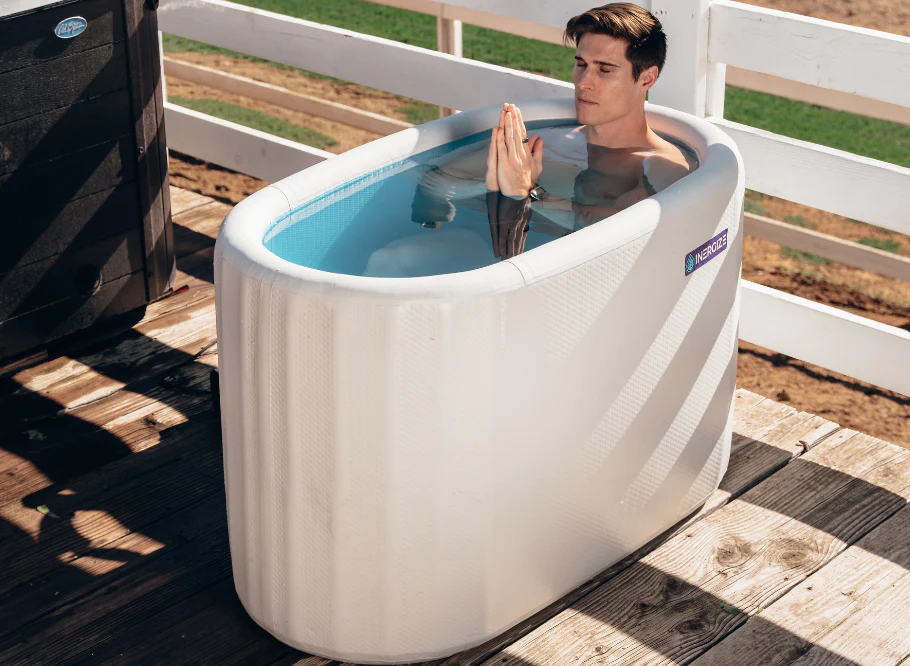
Inergize Cold Plunge
The Inergize Cold Plunge Tub takes your recovery routine to the next level! It’s a user-friendly, adaptable product that offers easy setup and breakdown. With temperature versatility, it can provide a refreshing cold plunge at 37 degrees or a soothing hot soak at 105 degrees. Fine-tune your recovery process and feel amazing in a fun way!
Percussion Massage Devices
Percussion massage devices, like massage guns, are handheld devices that use rapid, repetitive strokes to massage the body, helping to release muscle tension and improve circulation. These devices can be an excellent addition to your recovery routine, especially if you’re looking for a quick and effective way to:
- Alleviate muscle pain and tension
- Improve muscle recovery after playing pickleball
- Increase blood flow to the muscles
- Reduce muscle soreness and stiffness
Consider incorporating a percussion massage device into your post-pickleball routine for optimal recovery and performance.
The Therabody Theragun Elite is an incredible percussion massage device. I literally use mine ALL THE TIME. I use it just about every night for a few mintues, I use it in the morning before my workouts, and I take it with me to the pickleball courts as well! Yes, I know, a little odd, but then all my friends start using it as well.

Theragun Elite
The Therabody Theragun Elite is an amazing percussion massage device that provides deep muscle relief and promotes recovery. With QuietForce Technology delivering 40 lbs. of force, it’s powerful yet 75% quieter than previous models. The customizable speed range, OLED screen, and Force Meter allow for easy pressure adjustment. It has a comfortable grip and handle, a long battery life, and wireless charging. Connect to the Therabody app for customized routines. Includes five easy-to-clean foam attachments for comprehensive post-recovery.
Foam Rolling
Foam rollers are a popular self-myofascial release technique that can help you:
- Eliminate trigger points or ‘knots’ in the fascia, giving you a feeling of relief and relaxation
- Reduce muscle tension
- Improve flexibility
- Increase your range of motion
For optimal use of foam rolling, follow these steps:
- Begin by lying on the roller and exert pressure using your body weight.
- Roll slowly up and down the length of the muscle, pausing to focus on any tight spots.
- Remember to move slowly and apply pressure gradually for maximum benefit.
- Avoid rolling over joints or bony areas to ensure a safe and effective experience.
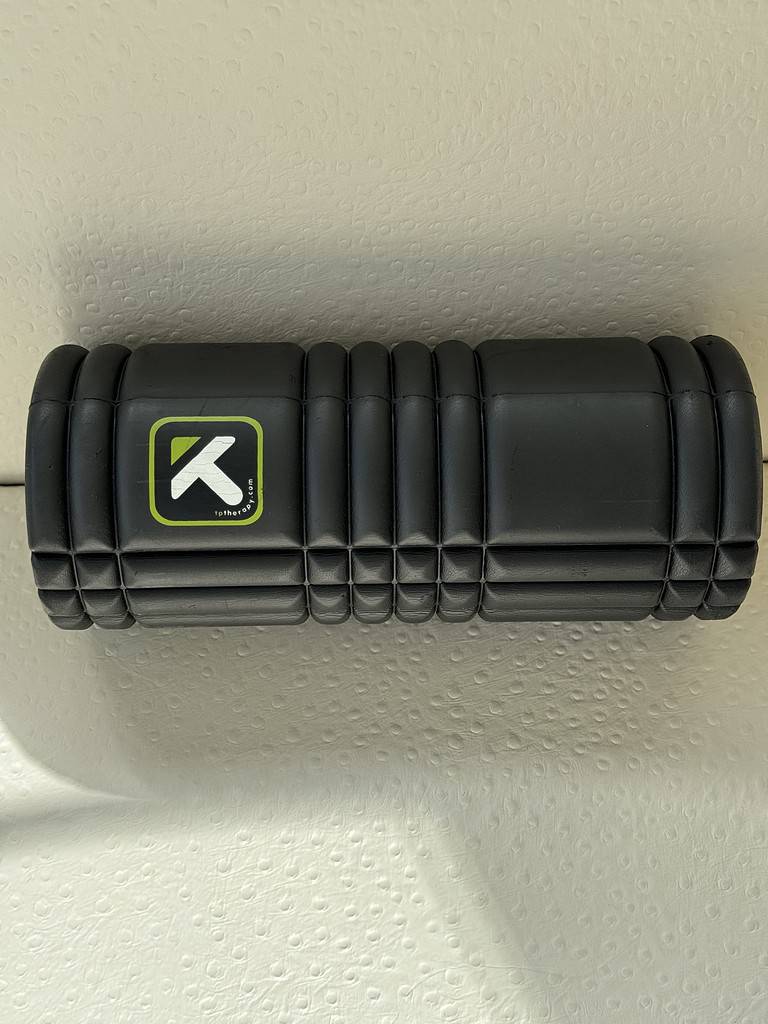
TriggerPoint Foam Roller
You hear it all the time. Use a foam roller. While I don’t use mine enough, when I do it feels oh so good! Upper and lower back, hips, quads, hamstrings! Foam rollers are some simple so just do it!
The TriggerPoint foam roller features a patented design with a durable exterior and rigid core, providing consistent performance without losing shape. Measuring 13 x 5.5 inches, it’s the perfect size for effective self-myofascial release. With a weight capacity of up to 500 pounds, it’s suitable for all. Plus, when you purchase, you’ll gain access to a free online instructional video library. A simple and effective way to relieve your muscles.
Air Compression Systems
Air Compression Systems offer a modern and highly effective way to stimulate muscle recovery and reduce the discomfort that may follow a rigorous pickleball game. These systems use dynamic compression to enhance blood flow, expedite the removal of exercise-induced waste like lactic acid, and reduce swelling and inflammation.
The device typically involves wrap-around attachments for various parts of your body—like the legs, arms, or hips—that inflate with air and apply pressure. The compression and relaxation cycle mimics the natural muscle pump of the body, which can significantly aid in recovery.
To use an air compression system effectively, follow these suggestions:
- Use the device within 2 hours after your pickleball game to kick-start the recovery process.
- Start with a low to moderate compression level, then gradually increase it as your body adjusts.
- Aim for sessions of around 15-30 minutes.
- If possible, elevate the treated limb to further assist circulation.
By integrating air compression systems into your recovery routine, you can ensure efficient recovery and maintain your pickleball performance in the long run.
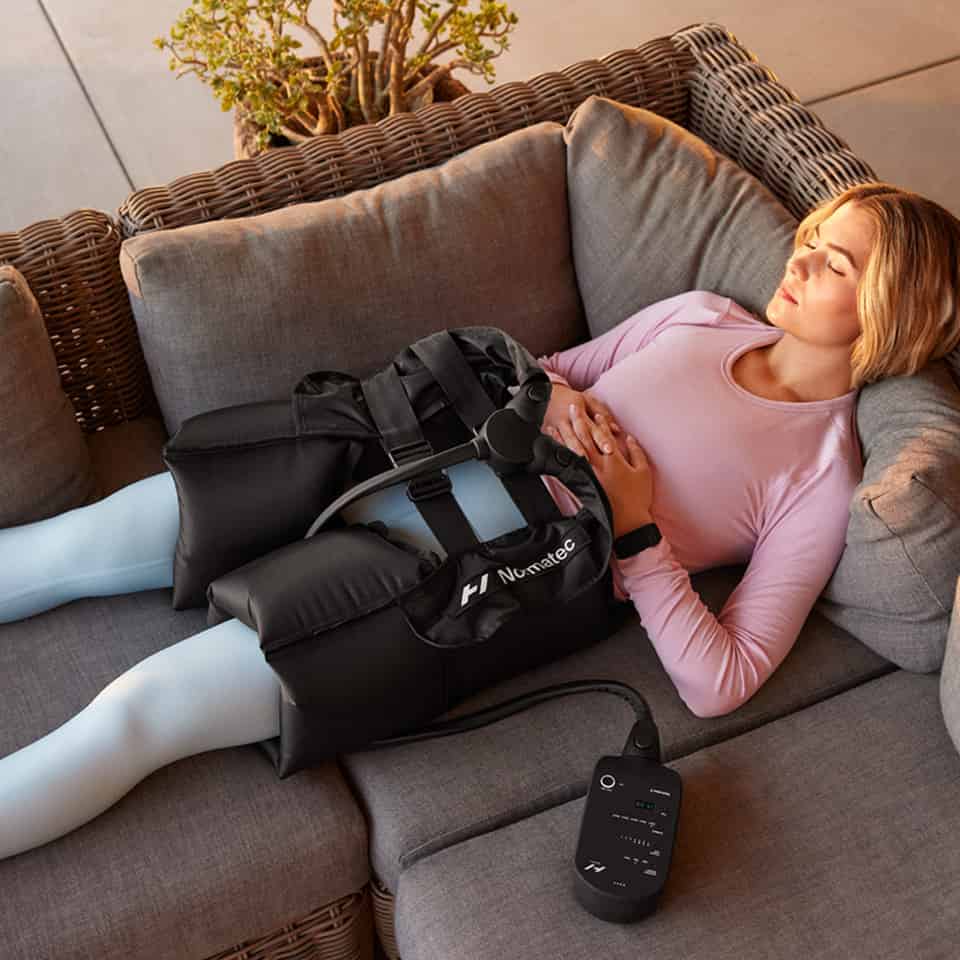
Hyperice Receovery Systems
Ok, they look funny I get it. And yes, a little weird when you put these on your legs. But again, wow. Yes, I have gone to facilities to get this done and it surely had any sort of pain and soreness that I had in my legs gone in no time!
Hyperice systems enhance your body’s recovery process by increasing blood flow and reducing inflammation. They come with attachments for specific body areas and customizable pressure settings. With HyperSmart technology, control the device through a Bluetooth-connected app. Lightweight and portable, ideal for home or on-the-go use. Impressive battery life, offering up to 2 hours of continuous use.
Massage Balls
Massage balls are another excellent tool for relieving muscle pain and tension. They can target specific areas of discomfort, promoting relaxation and recovery. By incorporating massage balls into your recovery routine, you’ll be able to:
- Alleviate muscle pain
- Reduce muscle tension
- Improve flexibility
- Enhance circulation
- Speed up recovery
Get back to playing pickleball sooner with the help of massage balls.
To use a massage ball effectively, follow these steps:
- Place the ball on the area of your body that is experiencing pain or tension.
- Gently roll the ball over the area, applying pressure as needed.
- Move the ball in a circular motion or use a back-and-forth motion for maximum relief.
With a bit of practice, you’ll find massage balls to be a valuable addition to your recovery arsenal.

Kieba Massage Balls
Again, simple and effective. The Kieba Massage Balls are fantastic for self-myofascial release, effectively eliminating muscle knots and tension. These lacrosse-sized balls are designed for trigger point therapy, rejuvenating your body by relieving sore and tight muscles. They’re easy to use: simply lean on the ball and let your body weight and gravity alleviate muscle tension. Perfect for home, the office, or the gym. Use them while sitting, lying down, or on a yoga mat. Small and portable, they’re easy to carry anywhere.
Compression Gear
Compression gear is another fantastic way to boost blood flow and muscle recovery. By applying as much pressure as needed to specific areas of the body, compression gear can help improve circulation, reduce inflammation, and accelerate the healing process.
Using compression gear before and after physical activity can help you improve circulation, reduce swelling, and prevent injuries. Some popular examples of compression gear include compression socks, sleeves, and wraps.
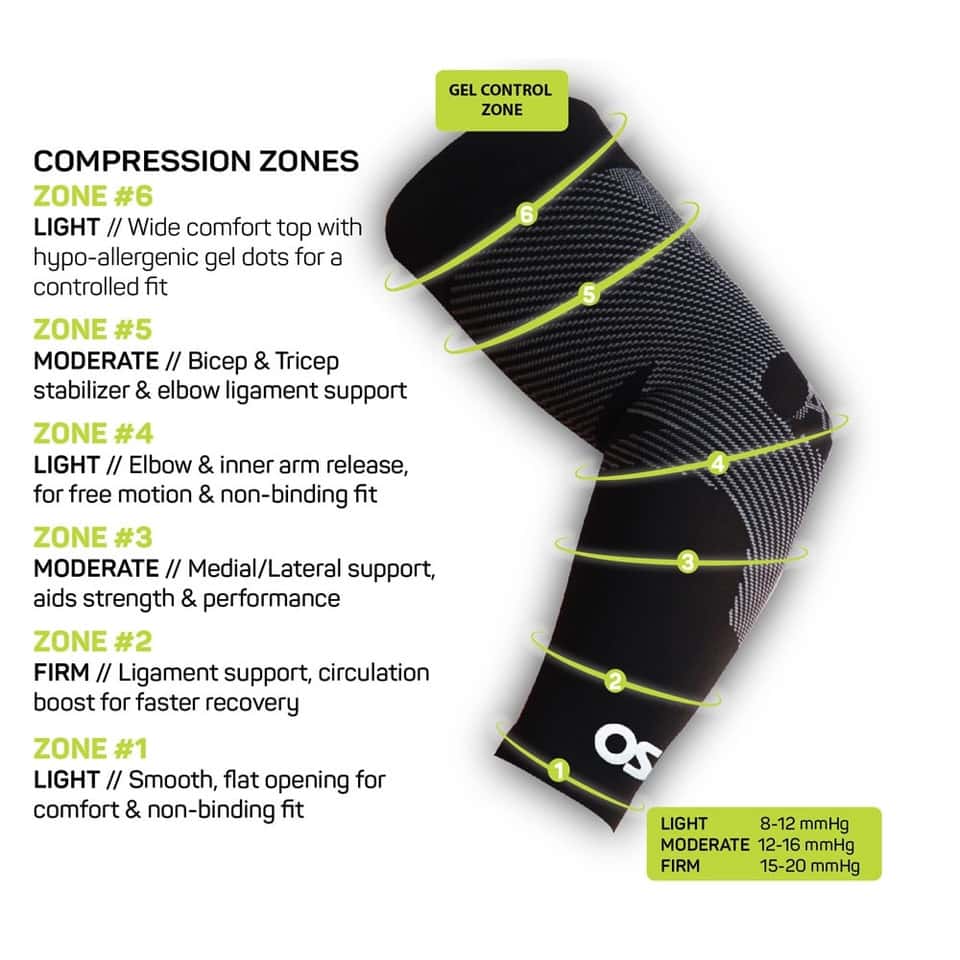
OS1st Compression Sleeve
I quickly fell in love OS1st products and I am confident you will too. They came in first on my best pickleball socks post.
The OS1st AS6 Performance Arm Sleeve is a fantastic tool for muscle recovery and reducing persistent aches. With its six-zone compression system, this sleeve effectively increases circulation, helping you recover faster. It’s great for issues like pickleball or tennis elbow and provides forearm support and tendon strengthening. Made with a thin, moisture-wicking material, the AS6 keeps your skin dry and offers antimicrobial properties. It also provides sun protection and stays securely in place during activities. Enhance your performance and comfort with the practical OS1st AS6 Performance Arm Sleeve.
Traditional Pickleball Recovery Methods
Rest and Recovery: The Key to Playing Pickleball Pain-Free
Enjoying pickleball without any pain or discomfort depends heavily on rest and recovery. Integrating a comprehensive recovery routine into your daily life not only helps prevent injuries but also enhances your performance on the court.
So, how can you strike the perfect balance between pushing yourself on the pickleball court and giving your body the rest it deserves? The answer lies in listening to your body and developing a recovery routine that works best for you.
I know it can be hard, but incorporating rest periods and recovery techniques can significantly reduce muscle soreness, improve blood flow, and decrease the risk of injuries.
The upcoming sections will guide you on how to tune into your body’s needs and set up a recovery routine.
Listen to Your Body
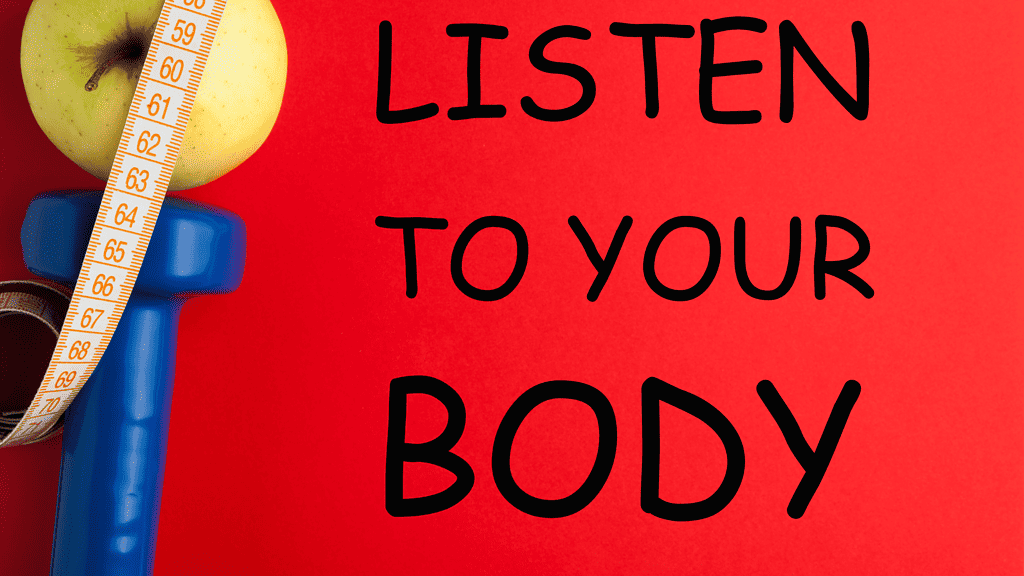
Simple, but hard to do. I get it, we want to be out on the court, but sometimes you just can’t. Or shouldn’t for that matter.
Pushing through muscle pain and continuing to play might seem like a good idea, but it could lead to injuries and long-lasting discomfort. Which, will keep you off the court even longer!
To avoid such problems, listen to your body and take breaks when needed. Rest is essential for muscle recovery, so don’t feel guilty or lazy when taking some time off. Keep in mind that rest is just as important as training. The human body can take a lot but it does need some recovery time!
Proper Nutrition
While physical activity is vital for a healthy lifestyle, nutrition plays an equally crucial role, especially when it comes to pickleball recovery. Eating a healthy diet that includes protein, carbohydrates, and healthy fats can help your body repair itself faster.
During recovery periods, opt for nutrient-dense foods such as lean proteins like chicken or fish, whole grains, and healthy fats from sources like avocados or nuts. Avoid sugary and processed foods, as they can slow down the healing process.
Proper nutrition and a good diet is key to maintaining a healthy body and continue playing on the pickleball court.
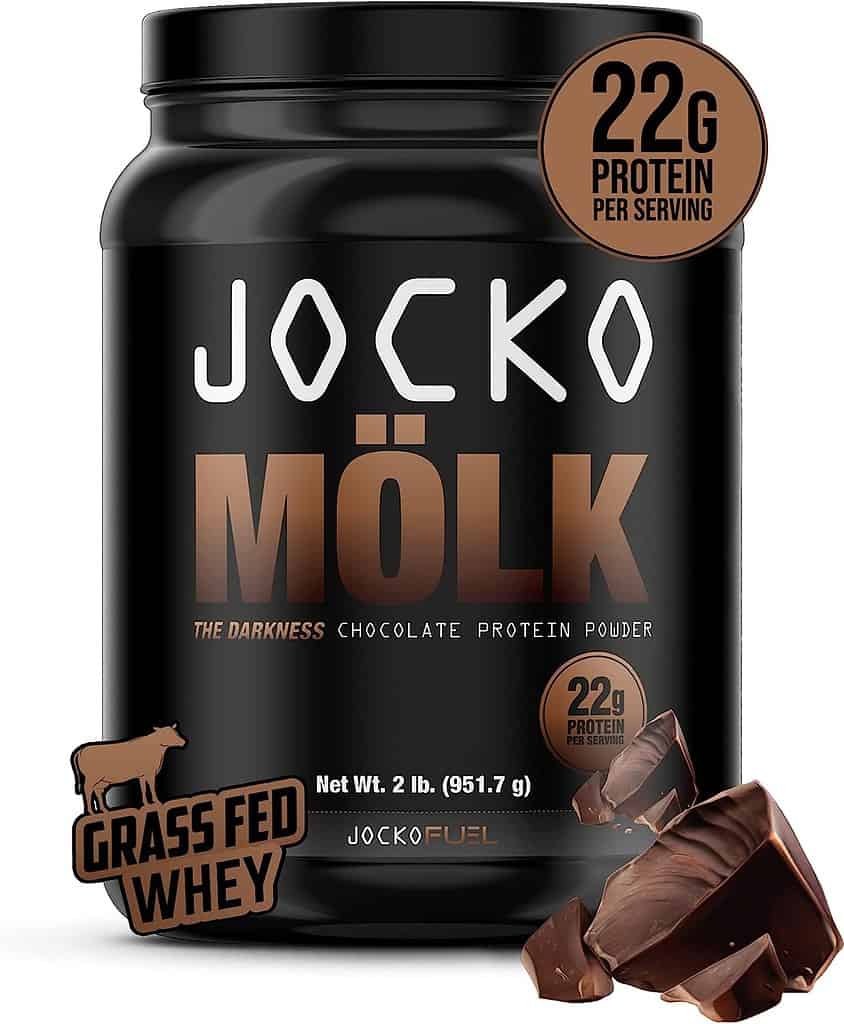
JOCKO MÖLK
Jocko is the man and he is bringing it with his protein poweder as well. I am a long time Jocko fan and user of his products. I have even attended his leadership training program. JOCKO MÖLK is a protein powder designed for a time-release digestion process to fuel muscle growth and recovery throughout the day. MÖLK features a rich profile of amino acids, the building blocks of protein, which aid in muscle building and immune function regulation. It also contains digestive enzymes and probiotics for smooth digestion and gut health. Get some!
Hydration
Staying properly hydrated is another key factor in effective muscle recovery. Hydration aids in maintaining normal body temperature, lubricating joints, and transporting nutrients to give you energy and keep you healthy. If you’re not hydrated, the body can’t perform at its highest level.
For pickleball players, this means drinking plenty of water before, during, and after playing. Dehydrated muscles may develop painful cramps, spasms, and tension.
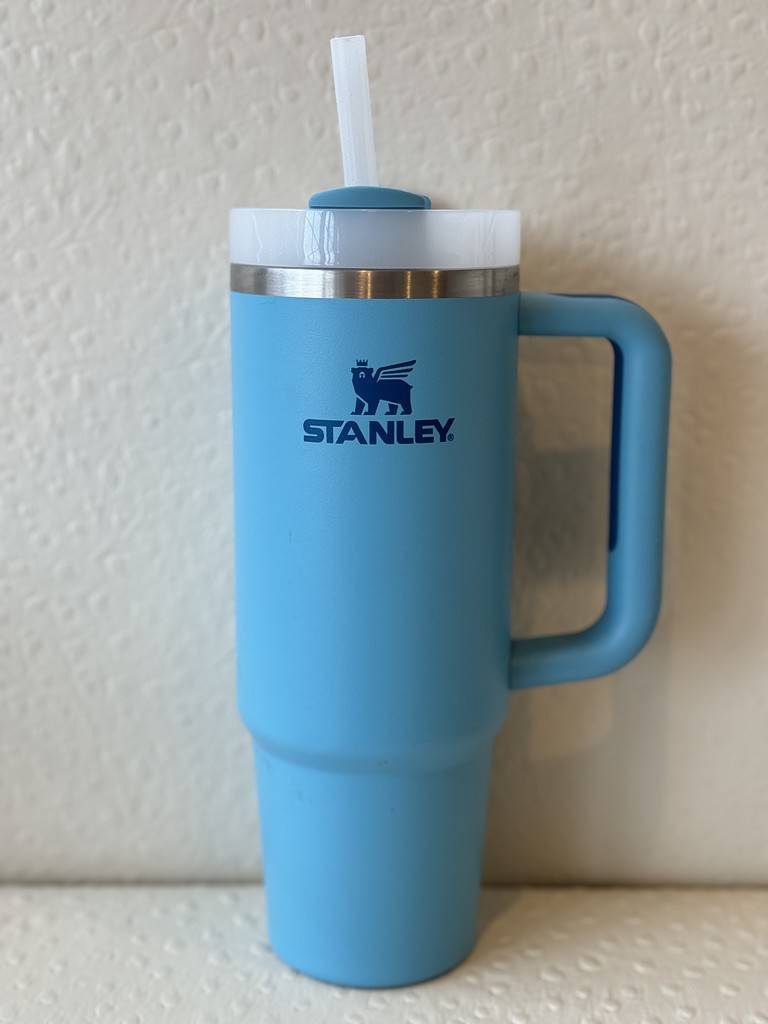
Stanley Water Bottle
You’ve seen them everywhere! They are a tiktoc sensation and that’s all it takes these days! But the Stanley Tumbler is really a great water bottle. After getting my kids them, I tried for my self. They keep the water ice cold for a long which I love, especially on the pickleball court. They are great looking, come in a lot of colors and sizes and hold up well to the constant wear and tear of daily use. Best of all, they fit in your car cupholder! Big win
Sleep: The Ultimate Recovery Tool
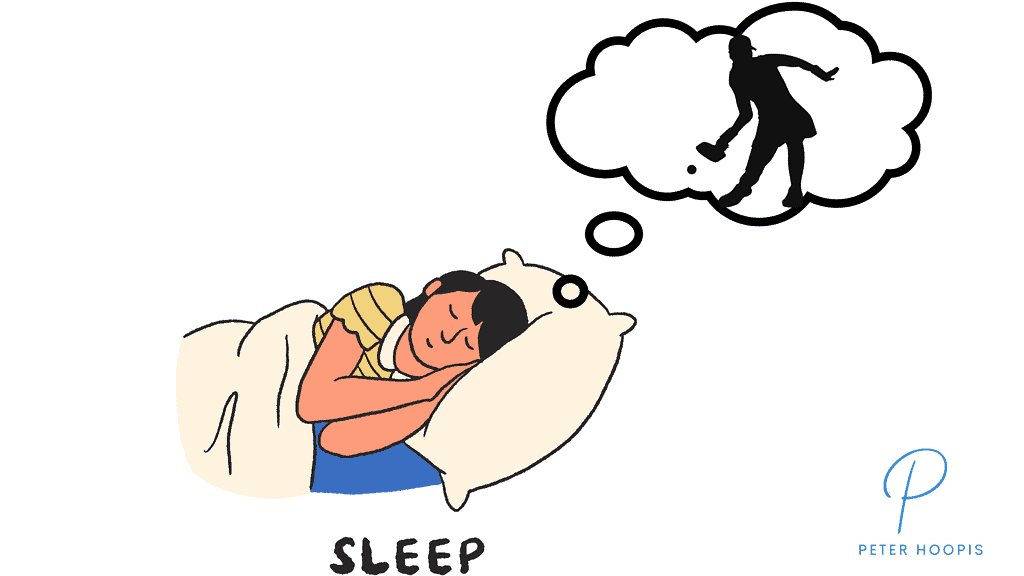
While sleep is often overlooked in recovery discussions, it actually forms a key component of a successful recovery routine. Aiming for 8-10 hours of rest after playing pickleball gives your body the chance to:
- Restore and revitalize
- Repair damaged tissues
- Replenish energy stores
- Strengthen the immune system
This allows you to bounce back faster and perform better in your next game.
To ensure you get a good night’s sleep, consider avoiding caffeine and alcohol before bed, creating a comfortable sleep environment, and establishing a regular sleep schedule. By prioritizing sleep, you’ll not only improve your pickleball recovery but also enhance your overall well-being and quality of life.
Cross-Training for Balanced Muscle Development
Cross-training is an effective way to achieve balanced muscle strength and endurance, helping you on the pickleball court. By incorporating activities such as:
- weightlifting
- running
- swimming
- cycling
- yoga
- Pilates
By incorporating muscle mass-building exercises into your fitness routine, you’ll be able to address muscle imbalances and build a strong, healthy body.
Cross-training not only helps you improve your pickleball performance but also builds balanced muscle mass strength and endurance, which are essential for success on the court. Make it a point to include a variety of activities in your fitness routine to keep things fresh, interesting, and enjoyable while reaping the numerous benefits of cross-training.
Stretching and Yoga
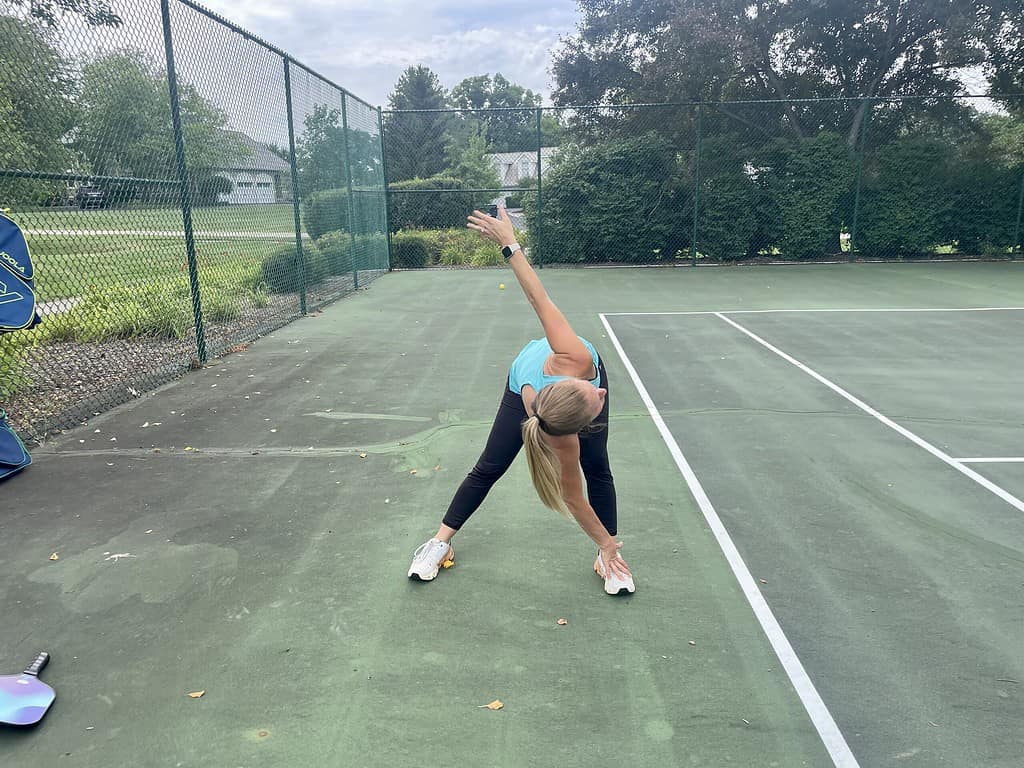
Stretching and yoga are not only great ways to unwind after a pickleball game but also essential tools for maintaining healthy and flexible muscles. I love to stretch and do it as much as I can. If I am stiff or sore, I always make an effort to stretch more.
Yoga, in particular, can help pickleball players increase flexibility and strength, leading to improved performance and an overall better playing experience.
To get started with stretching and yoga, try incorporating twists, lunges, and bends into your post-game routine. Breath control, an essential part of yoga, can help you relax and reduce stress, further promoting muscle recovery. A daily investment of a few minutes into these practices will yield significant enhancements in your flexibility, help with chronic pain, muscle health, and overall pickleball performance.
Supplements for Pickleball Recovery
In addition to all the aforementioned recovery strategies, the use of supplements can prove beneficial for pickleball recovery. Supplements aren’t a magic solution but they can support the body’s natural recovery process, providing the necessary nutrients that your body may not be getting enough of from your regular diet. They can help speed up muscle recovery, reduce inflammation, and replenish energy stores. However, it’s important to use supplements responsibly and in conjunction with a balanced diet and a sound recovery routine.
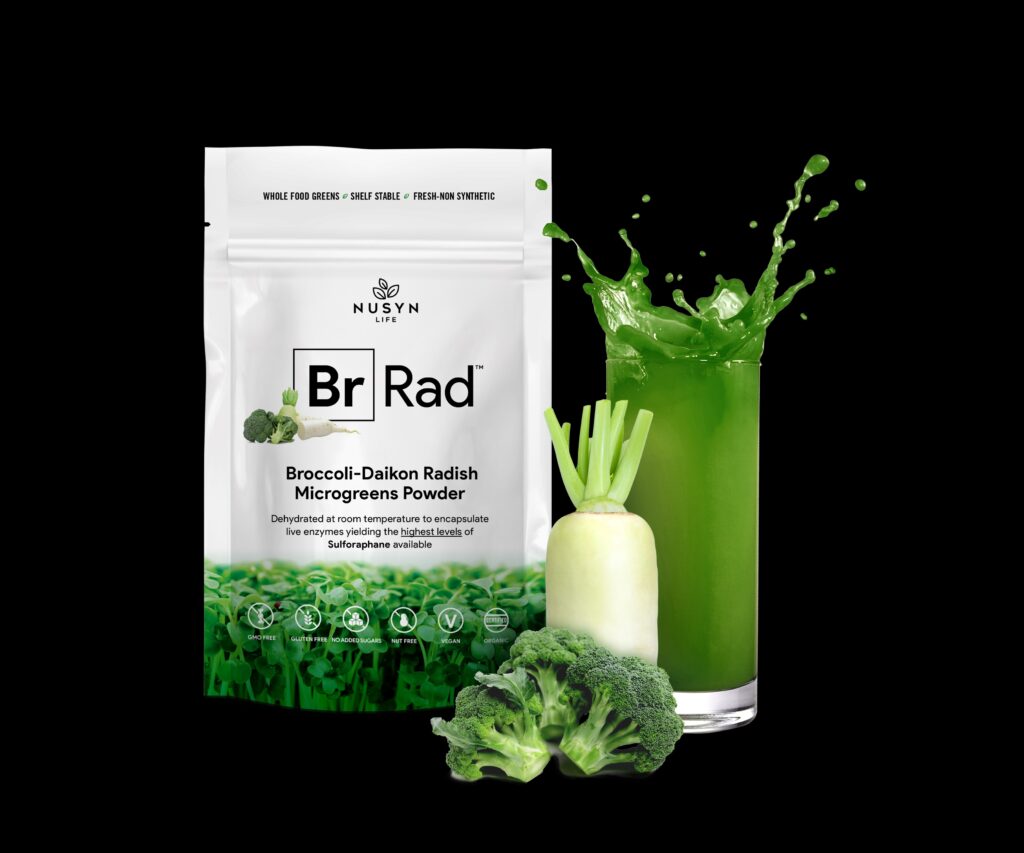
BrRad Microgreens
Pickleball demands quick movements, endurance, and fast recovery. That’s where BrRad comes in—a powerhouse of Micro-Green Broccoli and Radish packed with the highest concentration of Sulforaphane (SFN) available.
Grown in 100% organic material, our micro-greens are harvested and air-dried to preserve live enzymes—the key to unlocking SFN’s full potential. Clinically studied by Johns Hopkins University and the National Institute of Health, Sulforaphane has been shown to reduce body inflammation, helping combat muscle soreness, joint stiffness, and oxidative stress—the hidden culprits behind slow recovery.
Click here for a full write up on BrRad For Pickleball Recovery
Summary
In conclusion, pickleball recovery involves a combination of rest, proper nutrition, hydration, self-massage techniques, alternative therapies, sleep, cross-training, mental recovery, and supplements. By incorporating these strategies into your daily routine, you’ll be able to maintain a healthy, pain-free body and perform at your best on the pickleball court.
Remember, the key to successful pickleball recovery is listening to your body and finding the right balance between physical activity and rest. Stay consistent with your recovery routine, and you’ll be well on your way to becoming a stronger, more resilient, and happier pickleball player.
Conclusion
As pickleball continues to grow in popularity, so does the need for proper recovery methods. By incorporating massage balls, compression gear, rest periods, proper nutrition, and hydration into your routine, you’ll be able to prevent injuries and improve performance on the court.
Frequently Asked Questions
How do you recover from pickleball?
To recover from Pickleball, make sure to rest and ice any sore muscles. Compress the area with a bandage and elevate it to reduce swelling. To promote circulation and reduce stiffness, do some light physical activity like walking or swimming on rest days. Finally, eating a nutritious diet will ensure you stay energized during your matches.
Why do I get so sore after pickleball?
As with any sport, overstretching and overusing your body can cause pain and injury. Common pickleball injuries include muscle strains, fractures, elbow and knee pain, as well as tendinitis in the wrist. Take time to warm up before playing and cool down afterwards to reduce the risk of soreness and injury.
Why am I so tired after pickleball?
Dehydration due to sweating and breathing heavily can lead to weakness, fatigue, and nausea. To prevent these symptoms, make sure to hydrate yourself well before and after a pickleball match.
How do you relieve pickleball pain?
To relieve pickleball pain, it is important to stay active and take short walks or stretches every few hours. Treat acute injuries with the RICE method: rest, ice, compression and elevation. Chronic injuries should also be managed through cold therapy, compression and elevation.
How can I improve my blood flow for muscle recovery?
Improve your blood flow for muscle recovery by stretching, doing yoga, and wearing compression gear to aid your body’s natural healing process.

